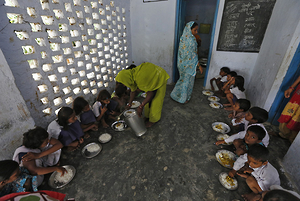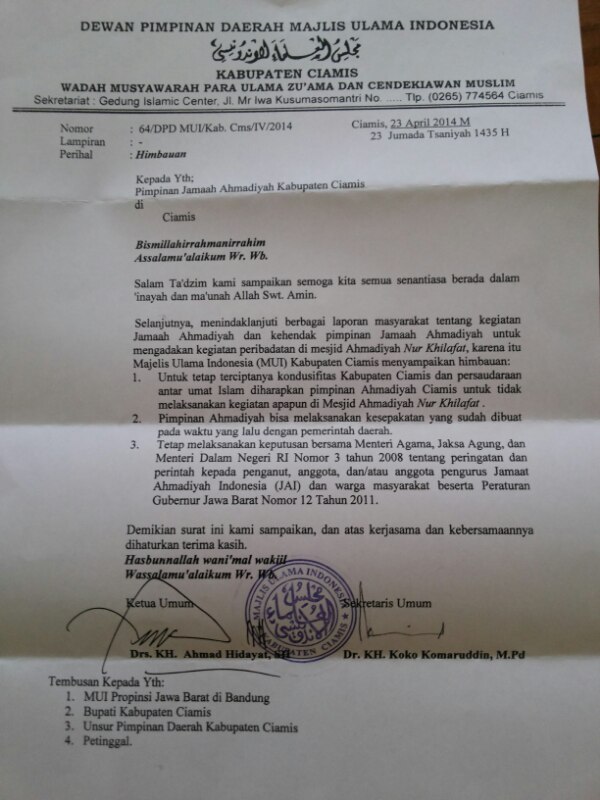 Over 40 percent of India’s children drop out of school before finishing 8th grade, despite a recent law designed to provide free and compulsory elementary education for all. Most students who quit school are from the lowest rungs of Indian society. A new Human Rights Watch report, “They Say We’re Dirty,” shows that discrimination by teachers and school officials fail to provide a welcoming and child-friendly school environment for these children. India researcher Jayshree Bajoria talks with Amy Braunschweiger about the consequences of persistent discrimination and what needs to change to keep these kids in school.
Over 40 percent of India’s children drop out of school before finishing 8th grade, despite a recent law designed to provide free and compulsory elementary education for all. Most students who quit school are from the lowest rungs of Indian society. A new Human Rights Watch report, “They Say We’re Dirty,” shows that discrimination by teachers and school officials fail to provide a welcoming and child-friendly school environment for these children. India researcher Jayshree Bajoria talks with Amy Braunschweiger about the consequences of persistent discrimination and what needs to change to keep these kids in school.
Who is dropping out?
Children from the poorest and the most marginalized communities such as Dalits – so-called “untouchables,” at the bottom of India’s caste system – Muslims and tribal members. Often these children are among the first generation in their families to have ever stepped inside a classroom, and very few of them make it to grade 8.
Why are they dropping out?
A number of reasons. The widespread problems of child labor and early marriage for girls are clearly factors. But our research shows the insidious and damaging impact of ingrained discrimination at school. Teachers will tell students from marginalized communities to sit in the back of class and then basically ignore them. They are often served their free school lunch only after all the other students. They are even asked to do tasks considered degrading, like cleaning the toilet – something that never happens to privileged kids. Teachers make derogatory remarks, or don’t stop more privileged children from ostracizing them. An unfriendly environment can make a child reluctant to attend classes, putting them at risk of dropping out.
Didn’t India enact a law guaranteeing, for the first time ever, an elementary education for all children?
The Right of Children to Free and Compulsory Education Act was an important step, though of course the challenges are enormous, considering the inequities built into Indian society for centuries. Since the law went into effect in 2010, primary school enrollment has shot up to nearly 100 percent, from 83 percent enrollment in 2001– a huge achievement for a country that six decades ago had staggering illiteracy levels. But while the law calls for a “child-friendly” classroom setting – one where each student is treated equally – this is clearly not happening in many places. And no one is being held responsible for creating unwelcoming environments.
What is a classroom like when it has this level of discrimination?
I had an eye-opening conversation in Uttar Pradesh state with the principal from a school attended by children from the Ghasiya tribe. The principal said that Ghasiya children are a big problem. She complained that they didn’t wear school uniforms, and that their parents were illiterate. She said they didn’t mix well and that they ruined the class for the other children – that nothing could be done with them. As I sat with her, we watched the Ghasiya kids walk into the school, and she pointed at them, saying, “See how dirty they are?” She complained that their eating habits were different, noting that these children ate meat, unlike the majority Hindus, many of whom are vegetarian. She even suggested that these children be put in a separate school.
Clearly, she did not like these children.
But here’s what really struck me: going over the school records, I saw that 59 Ghasiya children attended the school, and 58 of them, irrespective of their ages, were in the 2nd grade. There was clearly a kind of segregation happening. So I traveled to the hamlet where the community lived to hear their side of the story.
That’s incredible that they were all in the same grade. What did the children say when you met them?
I spent a lot of time with the children and after a while they opened up to me. They said that the teachers made them sit in a corner. If one of the Ghasiya kids touches another child who wasn’t Ghasiya, there’s a ruckus, complaints, and a scolding from the teacher. They said they want to learn, but they rarely had a teacher in their classroom – no one was even teaching them properly.
The children are routinely called dirty and told to take a bath. But their settlement has no water or electricity. The children have to walk a kilometer to fetch water, which makes them late for school if they bathe before class.
What else did you learn there?
My conversations with a girl we are calling “Meena” really affected me. One year after my first visit I returned to the school, and saw that none of the Ghasiya kids were there. So I went back to their village and spoke with Meena. She is 9 now, and when I first met her she was determined to learn but at the same time sad and angry about her treatment at school. A year later Meena told me that all the Ghasiya children were now rarely going to the government school and were attending a nearby charitable school. “Why should we go to government school when we don’t learn anything?” she said. “We will go to a school where they treat us with love.” Many are still at risk of dropping out.
Does the government know how many children are dropping out?
India doesn’t keep accurate track of children who have dropped out. One Indian state defines a dropout as a student with three months of unexplained absences, but other states say it’s one month or even seven days. How can the government set guidelines for intervening when students are in danger of dropping out if they don’t have a common definition for a dropout? Additionally, three school principals admitted to us that they were inflating attendance records because of the pressure they felt from education authorities.
But teachers still know what’s going on in their classrooms, don’t they?
They do, but they aren’t sure how to address the problem. When I asked principals and teachers at what point they worry about a child not coming to school, many said they didn’t know, and asked me how they should be addressing it. Many also said they had been told to never delete anyone’s name from the register. A key step to fixing this problem is that teachers should accurately record attendance, and there should be a common definition of when a child is considered to have dropped out of school. This would pressure educational authorities to act in time.
What do you want to see happen?
Thanks to the Right to Education Act, nearly all Indian children are getting enrolled in school. We want them to stay there until graduation, and to do so, India needs to create a classroom atmosphere that inspires all children to learn, regardless of their backgrounds. Teachers are often a child’s first role model, and a teacher’s attitude can go a long way to keeping children in class. Teachers and principals need to be trained in inclusion. It’s important for teachers who do discriminate to incur appropriate disciplinary measures. And India’s education authorities are not being held to account for failing to enforce the law properly. There just isn’t enough oversight.
Do you really think you can fix a problem as entrenched as discrimination with a law?
These are age-old attitudes. It will take time. But enforcing the education law will be an important step along the way.
Link: http://www.hrw.org/news/2014/04/22/qa-talking-discrimination-and-school-dropout-rates-india








